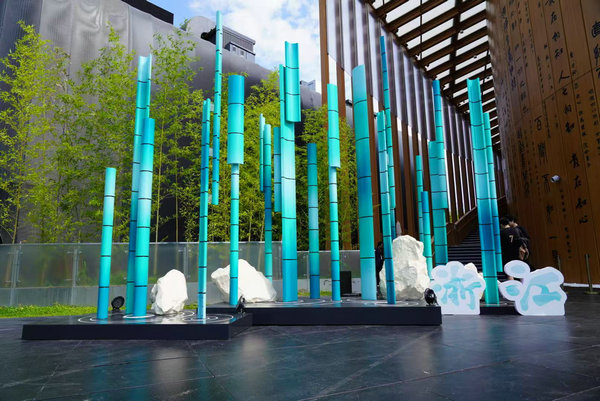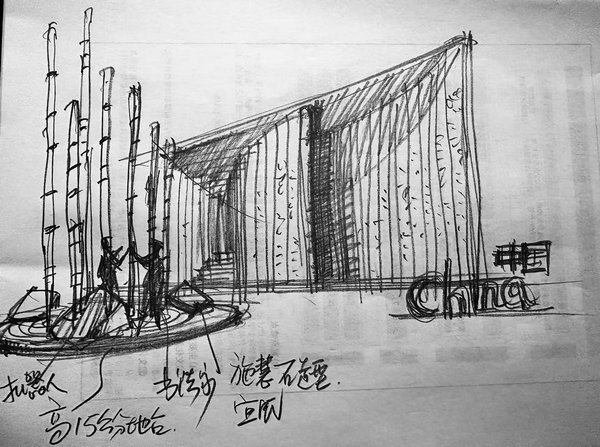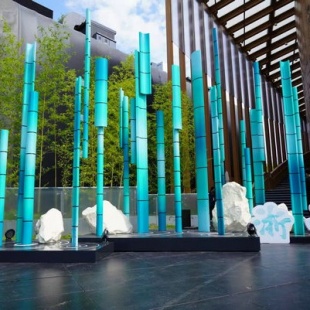Zhejiang's culture and innovative progress stand tall at expo


At Expo 2025 Osaka in Japan, a bamboo forest rises from the ground, its slender stalks etched with flowing Chinese calligraphy, surrounded by the quiet hum of robotic hands and mechanical dogs. Bamboo Rhyme, an outdoor installation, was unveiled as the centerpiece of Zhejiang Week at the China Pavilion this month.
Blending nature and tradition with technology and innovation, the installation invites visitors to a multisensory encounter that reflects Zhejiang province's vision for harmonious coexistence between humanity and nature.
Crafted from bamboo harvested in Zhejiang's Anji county, the work merges ancient aesthetics and cutting-edge artificial intelligence to showcase the province's cultural and technological vitality on the world stage.
"By bringing the installation to Osaka, we hope visitors will sense the deep and enduring power of traditional Chinese culture, while also glimpsing the boundless possibilities for future innovation," says Shen Hao, vice-president of the China Academy of Art.
"This installation offers a vivid interpretation of our theme: exploring how traditional culture can be creatively transformed and innovatively developed."
Shen emphasized that in the age of technology, the strength and spirit embodied by traditional culture, exemplified by bamboo, remain an inexhaustible source of inspiration for innovation.
For chief designer Lu Tao, bamboo was the natural choice to embody Zhejiang's cultural and ecological identity. "Bamboo Rhyme resonates deeply with the China Pavilion's core theme at Expo 2025 Osaka," Lu says.
"Bamboo holds deep symbolic value in Chinese culture. It grows endlessly, stands upright on its own, and flourishes in clusters. Its spirit aligns perfectly with the China Pavilion's design, which draws inspiration from ancient bamboo slips. Each line reflects Zhejiang's culture."
Anji, known as China's "hometown of bamboo", has lush bamboo forests that serve as "green banks "for local communities. Bringing this bamboo to the Expo highlights its ecological and global relevance.
Beyond its physical structure, the installation serves as a creative laboratory where traditional Eastern aesthetics meet futuristic technologies. Visitors encounter calligraphic verses penned directly onto bamboo — lines that evoke Zhejiang's poetic landscapes and philosophical spirit.
"Our calligraphers wield their brushes directly on the bamboo, writing lines such as 'Poetic and Picturesque Zhejiang' and renowned neo-Confucian scholar Zhu Xi's famous verse, 'Myriads of reds and violets reveal spring'," Lu explains.

These works interact with humanoid robots, intelligent bionic hands, and robotic dogs within a bamboo-constructed space.
This artistic vision naturally flows into the intricate calligraphy itself to reveal multiple layers of cultural meaning.
Feng Li, a calligraphy professor at the China Academy of Art, notes the stylistic diversity of the works: "Each verse captures and reflects Zhejiang's intellectual depth.
"The scripts, ranging from elegant kaishu (regular script) to flowing xingshu (semi-cursive) and caoshu (cursive script), showcase artistic diversity and offer audiences a profound cultural experience," Feng says.
Han Xu, vice-president of the China Academy of Art, says: "Zhejiang's culture is deeply rooted in Jiangnan's thousand-year cultural legacy, where bamboo has long stood as a living symbol of the region's enduring spirit." "Jiangnan "refers to the southern regions of the lower reaches of the Yangtze River.
"Bamboo Rhyme seeks to fully showcase Zhejiang's dual characters as Poetic Jiangnan and Dynamic Zhejiang, a region where profound cultural heritage converges with innovative technological vitality."
Han highlights the province's role as a hub for China's digital economy and artificial intelligence, home to enterprises like BrainCo and Unitree Robotics. He calls the installation "a contemporary expression of Zhejiang's integration of millennia-old cultural heritage with future-oriented digital technologies".





































